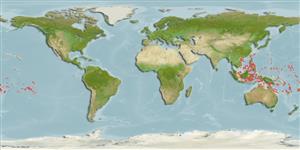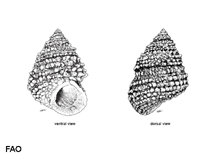Tectarius grandinatus (Gmelin, 1791)
Hailstorm prickly-winkle| Native range | All suitable habitat | Point map | Year 2050 |

|
| This map was computer-generated and has not yet been reviewed. |
| Tectarius grandinatus AquaMaps Data sources: GBIF OBIS |
Classification / Names Common names | Synonyms | CoL | ITIS | WoRMS
| Littorinimorpha | Littorinidae
Environment: milieu / climate zone / depth range / distribution range Ecologie
Rifbewoner. Tropical
Verspreiding Landen | FAO regio's | Ecosystems | Voorkomen | Introducties
Pacific Ocean: from the Philippines to Tonga, Cook Islands and French Polynesia.
Length at first maturity / Size / Gewicht / Leeftijd
Maturity: Lm ? range ? - ? cm Max length : 4.0 cm ShH mannelijk/geslacht niet bekend; (Ref. 349); common length : 3.0 cm SHL mannelijk/geslacht niet bekend; (Ref. 349)
Also found on jagged pieces of raised reef. Occurs at the high tide mark (Ref. 349).
Life cycle and mating behavior Geslachtsrijpheid | Voortplanting | Kuitschieten | Eieren | Fecundity | Larven
Members of the order Neotaenioglossa are mostly gonochoric and broadcast spawners. Life cycle: Embryos develop into planktonic trocophore larvae and later into juvenile veligers before becoming fully grown adults.
Voornaamste referentie
Referenties | Coördinator | Medewerkers
Poutiers, J.M. 1998. (Ref. 349)
Status op de Rode Lijst van het IUCN (Ref. 130435)
Status bij CITES (Ref. 108899)
Not Evaluated
CMS (Ref. 116361)
Not Evaluated
Gevaarlijk voor mensen
Harmless
Gebruik door de mens
| FishSource |
Tools
Meer informatie
Populaire namen
Synoniemen
Predators
Voortplanting
Geslachtsrijpheid
Kuitschieten
Fecundity
Eieren
Ontwikkeling van de eieren
Synoniemen
Predators
Voortplanting
Geslachtsrijpheid
Kuitschieten
Fecundity
Eieren
Ontwikkeling van de eieren
Internet-bronnen
BHL | BOLD Systems | CISTI | DiscoverLife | FAO(Publication : search) | Fishipedia | GenBank (genoom, nucleotide) | GloBI | Gomexsi | Google Books | Google Scholar | Google | PubMed | Tree of Life | Wikipedia (ga naar, zoek) | Zoological Record
Estimates based on models
Preferred temperature
(Ref. 115969): 24.9 - 28.8, mean 27.1 (based on 207 cells).
Prijsklasse
(Ref. 80766):
Unknown.



